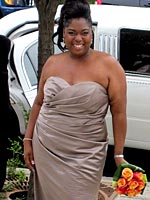5-Step Weight Loss Program for Permanent Weight Loss
Every Journey Worth Taking Begins with a Single Step
Here are five easy steps to gain control of your weight loss efforts. Start at the beginning, then take small steps, each and every day and you'll climb that mountain.STEP 1: State What You Want Now
"I want to lose 50 pounds."Is that achievable in the next month? If not, break it down into smaller mini-goals. "I want to lose 5 pounds this month."
What other ways can you say what you want, besides wanting to lose some weight?
"I want to step on the scale and see (state a number) pounds (remember, keep it something you can achieve in one month).
"I want to feel my pants getting looser."
"I want to see myself in the mirror wearing last year's bathing suit and it fits."
"I want to notice my clothes are getting too big for me."
"I want to easily bend over and touch my toes."
"I want to get up from a seated position, easily and gracefully."
Those are positive goals. Focus on what you want. How you want to feel, what you want to experience.
STEP 2: Make A Plan
Get out your weekly calendar and start with eating less (portion control), eating more (healthier foods), or eating differently in some way.STEP 3: Consider Exercise
Adding regular exercise helps more than anything else because the more active you become the more calories you burn, and if you build muscle, the more calories you'll burn at rest. What, when, how often? Do you need equipment, books, tapes or can you just get started and gather the other ingredients as you go?Write it all out. Your plan should include which days of the week and at what time. Don't make the mistake of trying to decide you'll exercise every day. You're not likely to stick to a plan that doesn't have build-in off days. Make it easy at first. You can always add more later.
STEP 4: Decide Whether Your Plan Is Workable For You
Take a look at your plan and decide whether it's possible. If not, make changes until it is.Start by listing each item, and then asking yourself how will you achieve this?
1. I want to eat less quantity. I'll achieve this by having half or three-quarters of the amount I usually have. See if that is sufficient. Keep a food diary for one week, religiously writing down everything that goes in your mouth.
2. I want to eat more healthier foods. I'll achieve this by adding more fruits and vegetables for snacks, so when I'm hungry, or think I'm hungry an apple or some carrots might be my snack of choice. This has the added benefit of more nutrition.
3. I want to eat differently. I'll achieve this by paying more attention while eating. Turn off distractions. Think of each bite as a separate event. Write down what I'm tasting and see what I notice now that I never noticed before? Different smells, sights, textures, and subtle tastes. I'll make an effort to really chew each bite at least 10 times.
4. I want to add some exercise. I'll achieve this by getting a book either at the library or a store, get a free pass to my closest gym, talk to friends, borrow exercise tapes. Find exercises I can do in front of the TV at first, or on the floor in my bedroom when I first get up or whatever works. No matter if others see me, I don't care. Start slowly, after the first few weeks, add more if I'm ready.
Close your eyes and imagine your plan.
If you chose getting up an hour earlier, can you see yourself doing it? Does it fit? Are you a night person? If so, an early morning workout probably won't pan out - stick to midday or evening workouts. Find what fits for you.STEP 5: Set Up Plan A And Determine What You Need To Get Started
Plan A: I need a small notebook I can carry with me for keeping track of daily foods (this is only needed for a week or two to get an idea of what I'm eating).Need monthly calendar to track my exercise minutes, even if it's only 10 minutes this month and 20 next, that's progress. You are after progress, not perfection. There is no such thing as perfection.
Visit library or order book online for using bodyweight for exercises. Pushups, crunches, etc., can be done without any extra equipment.
Buy healthy foods to have on hand such as fruits, cut up vegetables. Make dinner at least twice a week and freeze leftovers into ready-to-eat frozen meals.
Purchase or order supplements, protein powders, etc., if I want them.
Putting It All Together
Start working your plan. Don't wait for the next full-moon or some other arbitrary starting date. Just get started. The sooner you start, the sooner you begin to see results.If you use EFT (Emotional Freedom Technique), do it at least three times a day. It only takes a couple of minutes and you can do it while you do other things, so get it done. Check in with your list of behaviors you'd like to change, and then work on one issue each week or until it becomes a non-issue, then move to the next.
You might start with frustration that things aren't happening fast enough:
Example EFT statements:
"Even though I'm frustrated by all these instructions, I deeply and completely accept myself.""Even though I don't want it to take so much effort, I deeply and completely accept myself"
"Even though I hate all this and just want to wake up skinny, I deeply and completely accept myself."
No matter what, if you are putting attention on this process, then you are making progress. It doesn't matter if you keep to your plan exactly. What does matter is that you make a plan at all.
If you make a small effort every day you'll find that some days will be better than others, and that's okay. It's easy to forget, and fall back into our usual patterns which is why keeping a notebook handy helps keep you on track. So does scheduling your workout time just like you would any appointment, and then keeping it.
The point is not to be perfect--the point is to take action.
You can use a grading system, such as one point for achieving each item on your list, and tallying the points at the end of the week. You could also color in the squares on the calendar, so when you achieve what you planned, you color it in, but if you didn't achieve what you planned, you don't color it in. That way you can see at a glance how often the calendar is colored, how many squares are missing, etc. You can also see as months go by how you are improving. Having a visual display of your progress can help keep you on track. Remember, expect to be less than perfect in the beginning.If the idea that you won't be perfect is all it takes to keep you on a really strict path at first, that's fine, but be aware you'll likely slip a time or two in the following weeks. Think of it as nothing more than a learning experience, and go ahead to see if you can prove me wrong. That would be great. Just no matter what, no matter if it's been a week since you did anything on your list, it does not matter; just pick up where you left off and start again.
Small Changes Equal Big Results
There are 365 days in a year. If you achieved your goals on 200 of them this year, wouldn't that be an improvement over last year? As you improve, your weight will fall. That's how it works. That's why people who achieve their best weight and maintain it have learned how to stay "on plan" than "off plan." Eventually you don't really think of it as a plan at all but just how you are. It becomes your new way of life.I don't diet, and I never have yet I maintain my weight. I don't restrict myself but my choices are what makes the difference. I can eat candy, cookies and cake any time I want, but usually I don't want to. That's the difference. When someone says they can eat what they want, they mean they usually want to eat foods they know will support their health goals.
Use these five steps to get started on a plan, right now. Start by getting a small notebook, then starting writing down th days of the week, thinking about your schedule and how you'll make some changes to your routine. After all, it's your present routine that isn't working, so you must make some changes. Make them fit, and then you'll fit into those smaller jeans in no time and this time it will be a permanent weight loss.
By Kathryn Martyn, Master NLP Practitioner, EFT counselor, author of Changing Beliefs, Your First Step to Permanent Weight Loss, and owner of OneMoreBite-Weightloss.com
-
Fat Burning Furnace - Weight Loss Training Program Where Just 15 Minutes Sends Your Metabolism Flying!
Learn How to Lose 26 Pounds in 7 Weeks! Weight Loss Training Program W
-
The Diet Plate Cheap
Unlike other programs, The Diet Solution Program is a program which i
-
30 Fast, New Fat-Burners
-
Questions Answered on HCG for Weight Loss
Are you thinking of using HCG for weight loss? HCG for weight loss is
-
Fat Burning Furnace - Want to Use These Easy Exercises to Lose Weight Fast?
How to Lose 26 Pounds in 7 Weeks! Are you searching for easy exercises
-
Is The HCGdiet Safe?
While it has not been approved by the Food and Drug Administration, th
- DON'T MISS
- A Man Growing Boobs?
- Fat Burning Furnace - Is Your Metabolism Turned Off Right Now?
- Exercise Resistance! - The Secret Barriers that Prevent Weight Loss
- Need To Lose Those Extra Pounds? Discover Weight Loss For Women Programs
- Tips For Healthy Physical Lifestyle For Adults
- A Guide for Finding the Right Weight Loss Program
- Should We Avoid Carbs?
- 101 Days of Motivation For You!
- The Law Of Attraction And Weight Loss – Making Friends With Your Food
- Why Weight Loss Requires Strength Training, Even For Women And Seniors, Part 1




